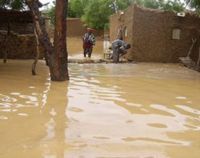
ACCRA, Ghana, 15 October 2007 – Akaappab Anyansa and her four young children are among the estimated 260,000 people affected by recent floods in Ghana. Luckily, she did not lose her two-room house, but she has been sharing her room with her neighbours since their house collapsed.
Already struggling to survive in a region where poverty and acute malnutrition is endemic, she now has to share her small stock of millet with nine people. They barely eat one meal a day.
“I boil green leaves and grass, and add salt and pepper. That is all I can give the children, but it doesn’t seem to be enough for them,” said Ms. Anyansa.
High risk of disease
Atanga Apeya and her children are at high risk of contracting the disease. Ms. Apeya is pregnant and her children are all under five years of age. They have lost their house and are living in a shelter.
A few days ago, health worker Nora Ayaric visited the family to give Ms. Apeya an insecticide-treated bednet, the proper use of which can reduce child mortality rates by 20 per cent. In cooperation with the Ministry of Health and other partners, UNICEF supported the distribution of 28,000 nets through the end of September. An additional 20,000 insecticide-treated nets have been ordered for delivery with other relief items.
The Ministry of Health will carry out a planned nationwide Integrated Child Health Campaign in late November. During the campaign, a total of 1.5 million bednets will be distributed along with vitamin A supplements, vaccines and deworming medicine.
“The timing is good. It means that at the end of the campaign, most children and pregnant mothers will be sleeping under a treated mosquito bednet and will be protected from communicable diseases,” said Dr. Young.